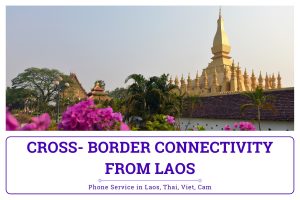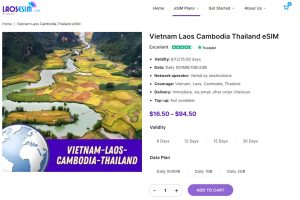Cross-Border Connectivity: Phone Service in Vietnam, Thailand, Laos, Cambodia
Traveling across borders in Southeast Asia often means dealing with changes in phone service and connectivity. However, there are now more options than ever to stay connected seamlessly as you explore Vietnam, Thailand, Laos and Cambodia. In this post, we’ll explore the mobile landscape in each country individually before looking at solutions for cross-country travel.

Phone Services in Each Country
Vietnam
Major Phone Carriers
Vietnam’s telecommunications market is dominated by three major players: Viettel, Vinaphone, and Mobifone. Their prepaid plans include a certain amount of data, local minutes, and texts. Prices can range from 50,000 VND to 300,000 VND (approximately $2 to $13 USD) depending on the package.
Thailand
Major Phone Carriers
Thailand’s mobile market is highly competitive, with three main players dominating the landscape: AIS, DTAC and True Move. Their prepaid plans are the most popular among tourists. They typically include a combination of data, local calls, and SMS. Prices can range from 100 THB to 1,000 THB (approximately $3 to $30 USD) depending on the package.
Laos
The telecommunications market in Laos is less developed compared to its neighbors, but it’s growing rapidly. The main carriers are: Unitel, LaoTel, ETL. The plans and rates in Laos are generally simpler compared to those in Thailand or Vietnam, they usually include a mix of data, local calls, and SMS. Prices can range from 20,000 to 100,000 LAK (approximately $2 to $10 USD).
Cambodia
Cambodia’s networks are Smart, Cellcard and Metfone, with good coverage in cities/towns and developing rural access. Prepaid SIMs start cheaply and top-up amounts are very flexible. They typically include a combination of data, local calls, and SMS. Prices can range from 2,000 to 20,000 KHR (approximately $0.50 to $5 USD) depending on the package.
Cross-Border Connectivity

Pocket Wifi – Convenient solution for group/family
The pocket WiFi contains a SIM card that provides high-speed LTE/4G data. It acts as a portable wireless router emitting WiFi signals for your devices to connect to, like a smartphone, laptop, or tablet. You can share the internet connection easily between devices.
Many electronics retailers and phone carriers in major cities rent pocket WiFi packages tailored for travelers. Options include single country rental or multip country plans to use seamlessly in Vietnam, Laos, Cambodia and Thailand. Rates are usually $3-5 per day or less for longer periods.
Purchasing Local SIM in each country
The popular option for border-hopping is to purchase a local SIM in each country, as roaming rates within networks are pricey. But several carriers now offer multi-country travel packs for continuous service.
Maxis and True Move have affordable eSIM profiles compatible across their partner networks from Bangkok to Hanoi. Vietnam’s Viettel also has favorable roaming agreements in Laos and Cambodia. WiFi is reliable along major transport routes if you prefer data-only access.
Multi-country eSIM – Special Travel Plans for Cross-Border Use

One easy option for connectivity across Vietnam, Laos, Cambodia and Thailand is getting a multi-country eSIM plan from popular eSIM providers, such as Laosesim, Gigago, Airalo, Holafly, and others. While international eSIM providers serve different countries and regions, Laosesim.com stands out as the premier choice for travelers to Southeast Asian countries (including Laos). As a Laos-focused specialist, Laosesim leverages deep local expertise as well as partnerships to deliver the most comprehensive and reliable local and multi-country eSIM plans.
Laosesim.com offers prepaid data-only eSIM plans that provide high-speed LTE/4G coverage on major networks in all four countries. Plans range from 8-30 days validity with 500MB-2GB of daily data. The eSIM can beeasily installed on compatible smartphones by scanning a QR code, no need to swap physical SIM cards. This allows for seamless connectivity without roaming charges as travelers move between the different countries.
Tips for Ensuring Connection at Borders
Here are some tips for ensuring connection when crossing borders:
- Research connectivity options in advance. Find out what cellular carriers and internet providers operate on both sides of the border so you can plan accordingly. coverage can vary significantly.
- Use WiFi whenever possible. Public spots at airports, hotels, cafes etc. can help you connect without using cellular data. Download maps and content before crossing.
- Keep devices charged. Don’t let low batteries cut you off when cellular signals are weakest at borders where networks may switch. Bring a portable charger.
- Adjust mobile network settings. You may need to manually select a local network operator on your phone after crossing rather than relying on automatic selection.
Being prepared with backup connectivity options is key to staying connected smoothly at borders where coverage can be intermittent.
Conclusion
In conclusion, navigating cross-border phone connectivity in Vietnam, Thailand, Laos, and Cambodia requires some planning and awareness of the challenges that may arise. By understanding the major carriers, recommended plans, and strategies for maintaining connectivity at borders, travelers can ensure they stay connected throughout their journey. Additionally, leveraging additional services like Wi-Fi hotspots, offline tools, and backup communication methods can further enhance connectivity and communication while on the road. Remember to research, prepare, and stay adaptable to make the most of your cross-country travel experience.








